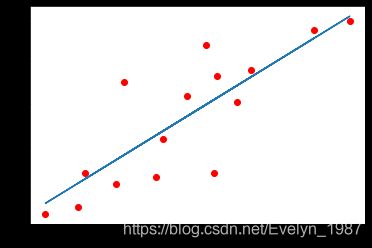pytorch学习笔记2-线性模型
pytorch学习笔记2-线性模型
- 一维线性回归
-
- 例1 随机设置点回归
- 多项式回归
-
- 例2 3次多项式回归
- 参考资料
一维线性回归
例1 随机设置点回归
# 引入numpy
import numpy as np
# 随机设置数据
x_train = np.array([[3.3], [4.4], [5.5], [6.71], [6.93], [4.168], [9.779], [6.182], [7.59], [2.167], [7.042], [10.791], [5.313], [7.997], [3.1]], dtype = np.float32)
y_train = np.array([[1.7], [2.76], [2.09], [3.19], [1.694], [1.573], [3.366], [2.596], [2.53], [1.221], [2.827], [3.465], [1.65], [2.904], [1.3]], dtype = np.float32)
# 引入matplotlib,用来画图,下面两句常用
import matplotlib as mpl
import matplotlib.pyplot as plt
# 绘制散点图
plt.scatter(x_train, y_train)
plt.show()
番外:
matplotlib的使用
# 将 numpy.array 转换成Tensor
import torch
x_train = torch.from_numpy(x_train)
y_train = torch.from_numpy(y_train)
# 定义一个简单模型
import torch.nn as nn # 不能丢
class LinearRegression(nn.Module):
def __init__(self):
super(LinearRegression, self).__init__()
self.linear = nn.Linear(1, 1)# 输入输出都是1维的
def forward(self, x):
out = self.linear(x)
return out
if torch.cuda.is_available():
model = LinearRegression().cuda()
else:
model = LinearRegression()
# 这段有ERROR,后面有解决方法
from torch.autograd import Variable
# 训练模型
num_epochs = 1000
for epoch in range(num_epochs):
if torch.cuda.is_available():
inputs = Variable(x_train).cuda()
target = Variable(y_train).cuda()
else:
inputs = Variable(x_train)
target = Variable(y_train)
# forward
out = model(inputs)
loss = criterion(out, target)
# backward
optimizer.zero_grad() # 归零梯度
loss.backward() # 反向传播
optimizer.step() # 更新参数
if (epoch + 1) % 20 == 0:
print('Epoch[{}/{}],loss: {:.6f}'.format(epoch+1, num_epochs, loss.data[0]))
ERROR
21行:
IndexError: invalid index of a 0-dim tensor. Use `tensor.item()` in Python or `tensor.item()` in C++ to convert a 0-dim tensor to a number
解决方法:
将 21行 loss.data[0] 改为 loss.item()
更改后代码如下:
# 这回对了,不报错了
from torch.autograd import Variable
# 训练模型
num_epochs = 1000
for epoch in range(num_epochs):
if torch.cuda.is_available():
inputs = Variable(x_train).cuda()
target = Variable(y_train).cuda()
else:
inputs = Variable(x_train)
target = Variable(y_train)
# forward
out = model(inputs)
loss = criterion(out, target)
# backward
optimizer.zero_grad() # 归零梯度
loss.backward() # 反向传播
optimizer.step() # 更新参数
if (epoch + 1) % 20 == 0:
print('Epoch[{}/{}],loss: {:.6f}'.format(epoch+1, num_epochs, loss.item()))
Epoch[20/1000],loss: 0.169452
Epoch[40/1000],loss: 0.169436
Epoch[60/1000],loss: 0.169431
Epoch[80/1000],loss: 0.169426
Epoch[100/1000],loss: 0.169420
Epoch[120/1000],loss: 0.169415
Epoch[140/1000],loss: 0.169410
Epoch[160/1000],loss: 0.169405
Epoch[180/1000],loss: 0.169400
Epoch[200/1000],loss: 0.169395
Epoch[220/1000],loss: 0.169390
Epoch[240/1000],loss: 0.169385
Epoch[260/1000],loss: 0.169380
Epoch[280/1000],loss: 0.169376
Epoch[300/1000],loss: 0.169371
Epoch[320/1000],loss: 0.169366
Epoch[340/1000],loss: 0.169362
Epoch[360/1000],loss: 0.169357
Epoch[380/1000],loss: 0.169353
Epoch[400/1000],loss: 0.169348
Epoch[420/1000],loss: 0.169344
Epoch[440/1000],loss: 0.169339
Epoch[460/1000],loss: 0.169335
Epoch[480/1000],loss: 0.169331
Epoch[500/1000],loss: 0.169326
Epoch[520/1000],loss: 0.169322
Epoch[540/1000],loss: 0.169318
Epoch[560/1000],loss: 0.169314
Epoch[580/1000],loss: 0.169310
Epoch[600/1000],loss: 0.169306
Epoch[620/1000],loss: 0.169302
Epoch[640/1000],loss: 0.169298
Epoch[660/1000],loss: 0.169294
Epoch[680/1000],loss: 0.169290
Epoch[700/1000],loss: 0.169286
Epoch[720/1000],loss: 0.169283
Epoch[740/1000],loss: 0.169279
Epoch[760/1000],loss: 0.169275
Epoch[780/1000],loss: 0.169271
Epoch[800/1000],loss: 0.169268
Epoch[820/1000],loss: 0.169264
Epoch[840/1000],loss: 0.169261
Epoch[860/1000],loss: 0.169257
Epoch[880/1000],loss: 0.169254
Epoch[900/1000],loss: 0.169250
Epoch[920/1000],loss: 0.169247
Epoch[940/1000],loss: 0.169243
Epoch[960/1000],loss: 0.169240
Epoch[980/1000],loss: 0.169237
Epoch[1000/1000],loss: 0.169233
# 预测结果
model.eval() # 将模型变成测试模式
predict = model(Variable(x_train))
predict = predict.data.numpy()
plt.plot(x_train.numpy(), y_train.numpy(), 'ro', label = 'Original Data')
plt.plot(x_train.numpy(), predict, label = 'Fitting Line')
plt.show()

注意:
model.eval() 将模型变为测试模式,因为有一些层操作,比如Dropout和BatchNormalization在训练和测试的时候是不一样的,所以需要通过这样一个操作来转换这些不一样的层操作。
多项式回归
例2 3次多项式回归
import torch
# 使用torch.cat()实现Tensor的拼接
def make_features(x):
x = x.unsqueeze(1)
return torch.cat([x ** i for i in range(1, 4)], 1)
将输入的数据扩展成矩阵形式
# unsqueeze(1)将原来的Tensor大小由3变成(3,1)
W_target = torch.FloatTensor([0.5, 3, 2.4]).unsqueeze(1)
b_target = torch.FloatTensor([0.9])
# x.mm(W_target)表示做矩阵乘法
def f(x):
return x.mm(W_target) + b_target[0]
#采样点,随机生成一些数得到每次的训练集:
def get_batch(batch_size = 32):
random = torch.randn(batch_size)
x = make_features(random)
y = f(x)
if torch.cuda.is_available():
return Variable(x).cuda(), Variable(y).cuda()
else:
return Variable(x), Variable(y)
#定义多项式模型
import torch.nn as nn
class poly_model(nn.Module):
def __init__(self):
super(poly_model, self).__init__()
self.poly = nn.Linear(3, 1)
def forward(self, x):
out = self.poly(x)
return out
if torch.cuda.is_available():
model = poly_model().cuda()
else:
model = poly_model()
import torch.optim as optim
# 定义损失函数和优化器
criterion = nn.MSELoss()
optimizer = optim.SGD(model.parameters(), lr=1e-3)
# 训练模型
epoch = 0
while True:
# 获取数据
batch_x, batch_y = get_batch()
# 前向传递
output = model(batch_x)
loss = criterion(output, batch_y)
print_loss = loss.item()
# 重置梯度
optimizer.zero_grad()
# 后向传递
loss.backward()
# 更新参数
optimizer.step()
epoch += 1
# 均方误差小于0.001时,停止优化
if print_loss < 1e-3:
break
参考资料
《深度学习入门之PyTorch》 廖星宇 编著
